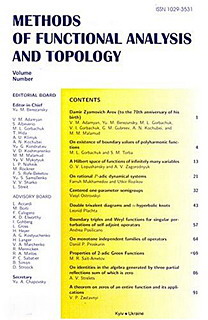Vol. 19 (2013), no. 3
Fedor Semenovich Rofe-Beketov (to his 80th birthday)
MFAT 19 (2013), no. 3, 197-198
197-198
Schrödinger operators with nonlocal potentials
Sergio Albeverio, Leonid Nizhnik
MFAT 19 (2013), no. 3, 199-210
199-210
We describe selfadjoint nonlocal boundary-value conditions for new exact solvable models of Schrödinger operators with nonlocal potentials. We also solve the direct and the inverse spectral problems on a bounded line segment, as well as the scattering problem on the whole axis for first order operators with a nonlocal potential.
Factorizations of nonnegative symmetric operators
MFAT 19 (2013), no. 3, 211-226
211-226
We prove that each closed denselydefined and nonnegative symmetric operator $\dot A$ having disjointnonnegative self-adjoint extensions admits infinitely manyfactorizations of the form $\dot A=\mathcal L\mathcal L_0$, where $\mathcal L_0$ is aclosed nonnegative symmetric operator and $\mathcal L$ its nonnegativeself-adjoint extension. The same factorizations are also establishedfor a non-densely defined nonnegative closed symmetric operator withinfinite deficiency indices while for operator with finitedeficiency indices we prove impossibility of such a kindfactorization. A construction of pairs $\mathcal L_0\subset\mathcal L$ ($\mathcal L_0$ isclosed and densely defined, $\mathcal L=\mathcal L^*\ge 0$) having the property${\rm dom\,}(\mathcal L\mathcal L_0)=\{0\}$ (and, in particular, ${\rm dom\,}(\mathcal L^2_0)=\{0\}$) is given.
On square root domains for non-self-adjoint Sturm-Liouville operators
Fritz Gesztesy, Steve Hofmann, Roger Nichols
MFAT 19 (2013), no. 3, 227-259
227-259
We determine square root domains for non-self-adjoint Sturm-Liouville operators of the type $$ L_{p,q,r,s} = - \frac{d}{dx}p\frac{d}{dx}+r\frac{d}{dx}-\frac{d}{dx}s+q $$ in $L^2((c,d);dx)$, where either $(c,d)$ coincides with the real line $\mathbb R$, the half-line $(a,\infty)$, $a \in \mathbb R$, or with the bounded interval $(a,b) \subset \mathbb R$, under very general conditions on the coefficients $q, r, s$. We treat Dirichlet and Neumann boundary conditions at $a$ in the half-line case, and Dirichlet and/or Neumann boundary conditions at $a,b$ in the final interval context. (In the particular case $p=1$ a.e. on $(a,b)$, we treat all separated boundary conditions at $a, b$.)
Spectral singularities of differential operator with triangular matrix coefficients
MFAT 19 (2013), no. 3, 260-267
260-267
For a non-selfadjoint Sturm-Liouville operator with a triangular matrix potential growing at infinity, we construct an example of such an operator having spectral singularities.
On exit space extensions of symmetric operators with applications to first order symmetric systems
MFAT 19 (2013), no. 3, 268-292
268-292
Let $A$ be a symmetric linear relation with arbitrary deficiency indices. By using the conceptof the boundary triplet we describe exit space self-adjointextensions $\widetilde A^\tau$ of $A$ in terms of a boundary parameter $\tau$. We characterize certain geometrical properties of $\widetilde A^\tau$ and describe all $\widetilde A^\tau$ with ${\rm mul}\, \widetilde A^\tau=\{0\}$. Applying these results to general (possibly non-Hamiltonian) symmetric systems $Jy'- B(t)y=\Delta(t)y, \; t \in [a,b\rangle,$ we describe all matrix spectral functions of theminimally possible dimension such that the Parseval equality holdsfor any function $f\in L_\Delta^2([a,b \rangle)$.


